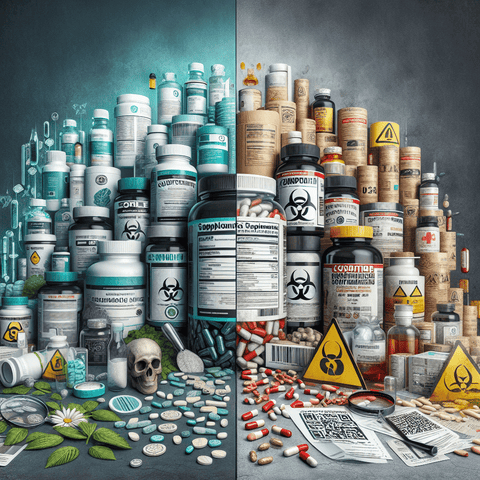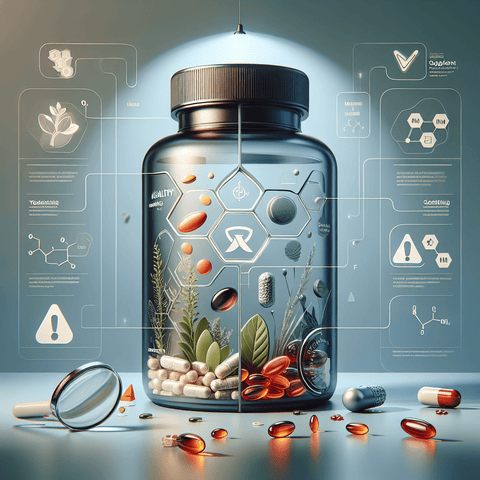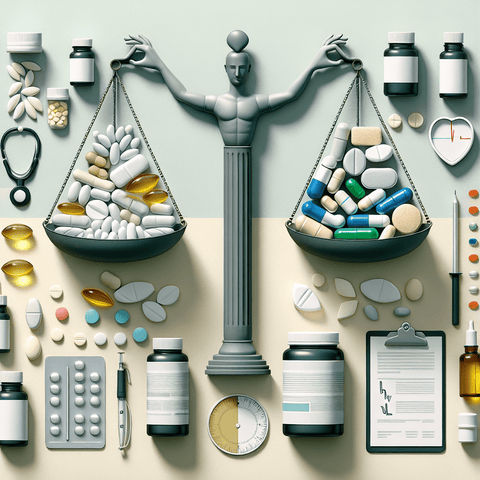Introduction
Over the past decade, the global dietary supplement market has experienced explosive growth, driven by mounting consumer interest in preventive health, wellness, and optimized nutrition. Supplements such as multivitamins, omega-3s, vitamin D, magnesium, and other micronutrients have earned their place in the daily routines of millions looking to bridge nutritional gaps, enhance immunity, and support their overall well-being. In tandem with this boom, online shopping has made access to health products more convenient than ever, allowing consumers to explore vast brands and formulations with just a few clicks.
Unfortunately, with increased demand and global reach comes a shadow market. A disturbing trend has emerged: fake or counterfeit supplements have made their way into not only obscure marketplaces but even some well-known platforms. These fakes are often repackaged to appear genuine, mimicking legitimate labels and designs. This deception can endanger consumer health, especially when products include unlisted ingredients, harmful contaminants, or simply ineffective dosages of active compounds. At best, customers waste their money. At worst, they risk serious adverse health reactions.
From economic ramifications to life-threatening outcomes, counterfeit supplements undermine consumer trust and damage the reputation of reputable brands. Understanding how to spot these fraudulent products has become a vital consumer skill. Whether you’re buying a vitamin D supplement for daily support or exploring high-quality omega-3s for cardiovascular health, being able to discern the real from fake is critical.
In this comprehensive guide, you’ll learn how to spot counterfeit supplements through practical strategies, label interpretation, source checking, and digital tools. Our mission is to equip you with the information needed to make informed decisions, avoid scams, and protect your health. With fake supplements an ever-increasing global concern, it’s time to sharpen your purchasing savvy and have full confidence in what goes into your body.
1. Understanding the Problem: The Rise of Fake Supplements in the Nutritional Industry
What exactly is a fake supplement? Counterfeit supplements refer to products that are marketed and sold as legitimate dietary or nutritional supplements, but within them lack the correct ingredients, contain harmful substances, or are fraudulently misrepresented in terms of dosage, composition, and origin. The intention behind these products is deceptive, and they are usually manufactured without adherence to regulatory safety standards or proper facility protocols. Unlike pharmaceuticals, which are subject to intense scrutiny and regulation, supplements operate in an often less-monitored grey zone—making the nutritional space appealing to counterfeiters.
The low barrier to entry in the supplement industry is one of the main reasons it is so vulnerable to counterfeit products. Small manufacturers without proper safety procedures can easily set up operations in countries with lenient enforcement and ship batches globally with misleading claims. The cosmetics-style packaging and the minimal regulatory oversight in some regions contribute heavily to the circulation of these dangerous goods. According to the World Health Organization (WHO), counterfeit supplements make up between 10% to 15% of the global supplement trade, with especially high incidents in countries where eCommerce is prevalent and regulation is weaker.
Consumers may mistakenly believe they’re buying from a trustworthy source, especially when prices are deeply discounted on third-party platforms. Unfortunately, these fake products often bypass customs or rely on forged documents to get through inspections. Once in the hands of unsuspecting buyers, they can easily pass as authentic unless the user knows the many red flags associated with counterfeit goods.
Beyond direct health risks, the rise of fake supplements also hurts legitimate health and wellness businesses. Fake products can negatively impact brand reputation, causing consumers to lose faith even in reputable sources. Consider a recent high-profile seizure where authorities discovered over a million euros’ worth of counterfeit multivitamins labeled with forged certification logos and safety icons. News like this underscores the need for companies and consumers alike to be vigilant.
While regulators and legitimate manufacturers do their part, the most effective defense starts with the end-user. The more knowledgeable consumers become about where to buy supplements safely, how to recognize legitimate labels, and which certifications to trust, the more counterfeiters will be forced out of the market due to lack of demand. Awareness is the strongest shield in today’s supplement landscape, and sections ahead will delve into actionable tactics that protect your health and investment.
2. The Dangers of Counterfeit Vitamins: Potential Health Risks and How to Avoid Them
Counterfeit vitamins present unique dangers that go beyond simple economic waste—they carry severe and sometimes irreversible health risks. Unlike other types of products where a fake item may just mean reduced performance (e.g., a counterfeit handbag or a pirated DVD), fake health supplements can directly affect your body, sometimes causing adverse events due to toxic substances, incorrect dosages, or completely unregulated production environments.
One of the defining risks of fake vitamins is the presence of contaminants like heavy metals, prescription drugs, or banned substances not declared on the label. In some 2021 analyses carried out by EU health agencies, counterfeit vitamin products sourced through online platforms contained lead, arsenic, and illicit anabolic steroids. These ingredients not only render the supplement ineffective but potentially toxic—even lethal. In individuals with comorbidities like kidney or liver conditions, such contaminants exert additional strain on already compromised organs.
Other counterfeit supplements may simply not include the advertised vitamins at all. For example, suppose you are relying on a vitamin C supplement for immune support; a fake version devoid of actual vitamin C leaves your health goals unmet, potentially exacerbating deficiencies or delaying healing during illness. Inaccurate dosing, where 1000 mg tablets only contain trace elements of the active compound, is another common tactic among counterfeiters.
Case reports further illustrate the realities of these dangers. Numerous hospitalizations worldwide point back to counterfeit vitamins sourced through unverified dealers or suspiciously low-priced websites. In one widely reported incident, several users suffered liver toxicity following consumption of a counterfeit multivitamin purchased via a third-party seller. Lab analysis later revealed high levels of undeclared compounds, none of which appeared on the package labeling.
The best way to avoid these dangers starts with evaluating known brand reputations and checking for proper certifications. Choose brands that subject their products to third-party verification—a sign of manufacturing transparency. Consumers should favor supplements that meet Good Manufacturing Practices (GMP) and are validated by the European Food Safety Authority (EFSA) where applicable. Reputable brands often include detailed certificates of analysis from independent labs or online verification tools to attest to ingredient integrity and safety.
Additionally, if a supplement's health claims seem too good to be true—"instantly improve energy overnight" or "reverse bone loss in 3 days"—run the other way. These are classic scam traps. EFSA regulations permit only scientifically validated claims, so responsible supplement vendors avoid exaggerated health promises. Always consult a healthcare provider before starting any new supplement, particularly if you are correcting a known deficiency like vitamin D or magnesium, both of which are available in quality formulas from Topvitamine.com.
3. Evaluating Supplement Authenticity: Key Signs of a Legitimate Product
When trying to validate whether a supplement is authentic, the first and most crucial step is a thorough inspection of the product packaging and brand credibility. Authentic brands that value consumer trust go to great lengths to be transparent. Look first for quality assurance seals—widely recognized third-party certifications that verify the product’s contents and manufacturing standards. These include:
- USP (United States Pharmacopeia): Tests product quality, purity, strength, and consistency.
- NSF International: Ensures products contain what's listed on the label and are free from harmful levels of contaminants.
- Informed Choice/Informed Sport: Typically appear on sports nutrition products, endorsed for athletes.
European supplements may also feature identifiers legislated or encouraged by local regulatory authorities like EFSA. While EFSA itself does not offer product certifications, it sets legally approved health claims that legitimate supplement producers follow.
Batch numbers and expiration dates are also essential indicators. These not only provide traceability but demonstrate a product’s manufacturing integrity. A genuine supplement will always feature a lot or batch number along with a clear “best before” or “expiry” date printed—not stickered—on the label. The absence of these might signify a fake.
Country of origin is another authenticity cue. For example, many trusted supplements in the EU originate from countries like Germany, the Netherlands, and the UK, where manufacturing is highly regulated. High-end supplements sold on Topvitamine.com always detail their production origins and include contact information for manufacturers, another good faith gesture made by respectable brands.
Reading the ingredient label is vital. Transparency should mean a full breakdown of active and inactive ingredients with nothing obscured behind generic phrases like “proprietary blend.” If an herb or compound lacks a specified amount in mg or IU, be wary. Labels should also reveal allergen information, daily recommended doses, and proper storage instructions. Digital QR codes are a growing verification trend; when scanned, these should direct you to the official website or documentation on the batch and lab results. Avoid QR codes that lead nowhere or dead links.
Finally, authenticity also includes handling and storage across the supply chain. Heat-sensitive supplements, such as certain probiotics or vitamin D3 formulas, must be stored within specific temperature ranges. If a shipment arrives with damaged seals or slightly discolored tablets, contact the seller. At reputable retailers like Topvitamine.com, conditions during storage and shipment are tightly controlled, ensuring your vitamin D supplement or magnesium complex maintains maximum potency throughout its shelf life.
In the next sections, we’ll explore how counterfeiters attempt to bypass these safeguards and tricks they use to entice consumers into buying unsafe products. But remember, every detail on that bottle or webpage matters—including those you can’t easily see without knowing where to look.



